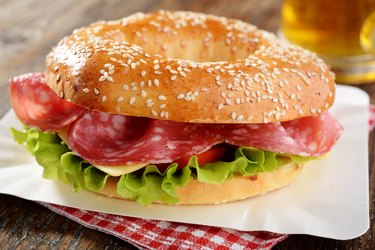
Most Americans eat more bread than they think. You probably have toast for breakfast, a sandwich, panini or sub for lunch, and a few pieces of garlic bread with your dinner. Breads also include pizza dough, burger buns, bagels, English muffins, French baguette, rolls and croissants. Most breads are relatively low in fat and high in carbohydrates, which fit U.S. Department of Agriculture dietary guidelines. However, if you have high triglycerides, eating a lot of bread could actually worsen your situation and impair your cardiovascular risk profile.
Carbohydrates and Triglycerides
Video of the Day
Triglycerides are a type of fat in your blood that differs from blood cholesterol levels. Triglycerides below 100 milligrams per deciliter are best to lower your risk of developing heart disease. Many factors can elevate your triglycerides, including abdominal obesity, lack of physical activity, smoking, stress and alcohol. In your diet, carbs, rather than fat or dietary cholesterol, are the nutrient that is the most associated with high triglycerides. If your diet contains excessive amounts of starches or sugars, your body will start converting these extra carbohydrates to fat, or triglycerides, and your triglyceride levels might rise above the desirable range.
Video of the Day
Bread and Carbohydrates
Bread is one of the largest sources of carbs in the American diet. Whether you choose refined grains, whole wheat or whole grains, all grain-based products contain significant amounts of carbs. For example, a slice of bread usually provides about 15 grams of carbs, a bagel has 66 grams of carbs, a croissant contains 31 grams of carbs, a slice of pizza provides between 36 and 41 grams of carbs, and a 12-inch sub contains more than 90 grams of carbs. If you eat several bread products each day, or eat a large serving size, your triglycerides could be high.
Low-Carb Diets and Triglycerides
If carbs are a big part of your diet, reducing your bread intake or eliminating bread completely, at least for a certain period of time to assess how this change could influence your health, could help you bring your triglycerides within the target range. In one study, people with obesity who limited their carb intake by reducing bread and other carb-rich foods for a year and were able to lower their triglycerides by 59 milligrams per deciliter, according to a study published in May 2009 in the "American Journal of Clinical Nutrition." The group assigned to the low-fat diet reduced their triglycerides to a lesser extent, by 32 milligrams per deciliter.
Limiting Your Bread Intake
If you feel like your diet is rich in bread and other high-carb foods, try limiting your intake of bread and sugar-containing foods for a period of one month. Before getting started, consult your doctor to first discuss your dietary changes and get some blood work done so you have something to compare your triglyceride levels to once you have reduced your bread intake. Replace your toast at breakfast with a bowl of steel-cut oats or an omelet with spinach and cheese. Instead of your sandwich at lunch, have a big salad or use lettuce leaves to make a bread-less wrap. For dinner, make a pizza on grilled eggplant slices or portobello caps or simply serve chicken, fish or meat with a big pile of nonstarchy vegetables, such as asparagus, broccoli or bell peppers cooked in olive oil. Try including at least two weekly serving of omega-3 fatty acid-rich fish, such as herring, salmon, albacore tuna, sardines or trout because omega-3 fats can also help reduce your triglycerides.
- "American Journal of Clinical Nutrition"; "Long-Term Effects of a Very-Low-Carbohydrate Weight Loss Diet Compared With an Isocaloric Low-Fat Diet After 12 months"; Grant Brinkworth et al; May 2009
- U.S. Department of Agriculture and U.S. Department of Health and Human Services: 2010 Dietary Guidelines for Americans
Is this an emergency? If you are experiencing serious medical symptoms, please see the National Library of Medicine’s list of signs you need emergency medical attention or call 911.